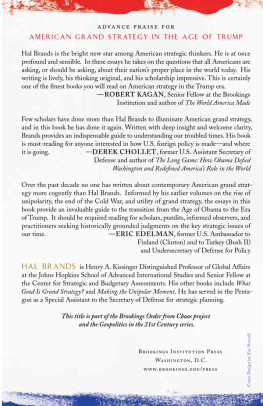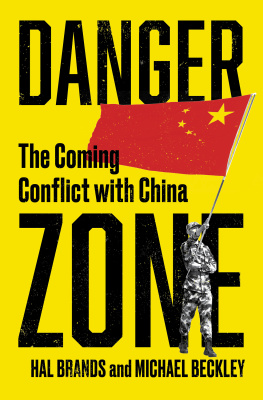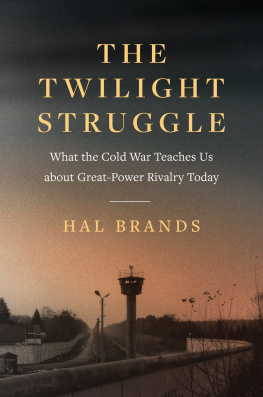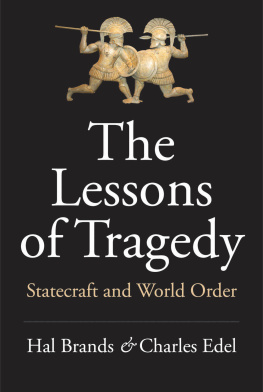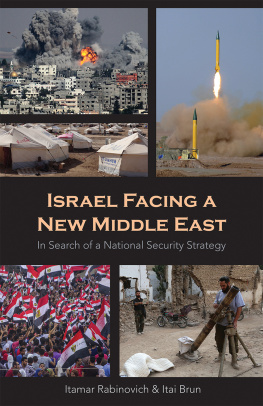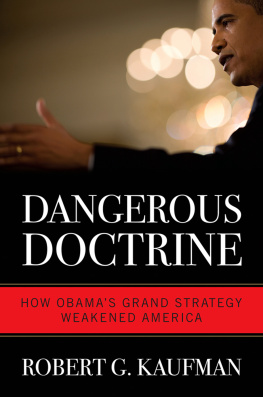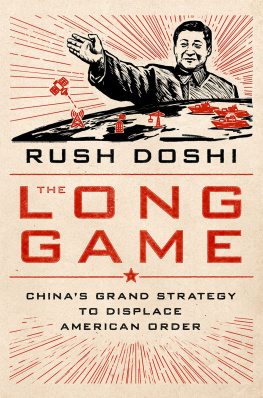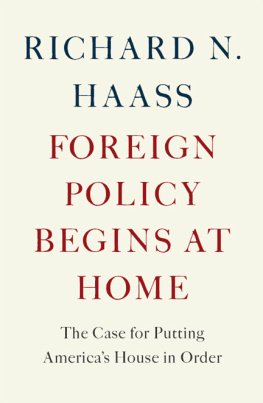AMERICAN GRAND STRATEGY IN THE AGE OF TRUMP
HAL BRANDS
BROOKINGS INSTITUTION PRESS
Washington, D.C.
Copyright 2018
Hal Brands
All rights reserved. No part of this publication may be reproduced or transmitted in any form or by any means without permission in writing from the Brookings Institution Press.
The Brookings Institution is a private nonprofit organization devoted to research, education, and publication on important issues of domestic and foreign policy. Its principal purpose is to bring the highest quality independent research and analysis to bear on current and emerging policy problems. Interpretations or conclusions in Brookings publications should be understood to be solely those of the authors.
Library of Congress Cataloging-in-Publication data are available.
ISBN 978-0-8157-3278-5 (cloth : alk. paper)
ISBN 978-0-8157-3279-2 (ebook)
9 8 7 6 5 4 3 2 1
Typeset in Minion Pro
Composition by Westchester Publishing Services
Contents
Preface and Acknowledgments
We live in a time of disruption, uncertainty, and contention in American grand strategy. The election of Donald Trump in November 2016 raised profound questions about Americas global rolenot just about how the day-to-day chaos of Trumps presidency would affect Washingtons many foreign relationships, but about what the rise of a leader whose campaign rhetoric rejected so many long-standing tenets of U.S. foreign policy might indicate about the future of Americas approach to the world. Nor is Trump the only source of debate and disquiet in American grand strategy today. For regardless of who triumphed in the 2016 presidential election, the United States would have had to confront numerous fundamental questions about how it has addressed the international environment in the recent pastand how it will do so in the years to come.
Has America really blundered about quixotically on the global stage since the end of the Cold War, or has its grand strategy actually been fairly sensible and effective? Did the Obama administration leave a disastrous legacy of U.S. retreat and metastasizing international chaos, or did it execute a shrewd approach that maximized U.S. power for the long term? What would happen if the United States radically pulled back from the world in the face of a more difficult geopolitical panorama, as many leading international relations scholars advocate? Is the tradition of American internationalism politically sustainable in light of the rise of Donald Trump? What might a more nationalistic grand strategy look like, whether in the age of Trump or after, and what might its effects be for the United States and the international system? How much military power is necessary to sustain the ambitious grand strategyand relatively benign international orderto which America has become accustomed, at a time when the geopolitical threats to that strategy are more severe than at any time in a generation? All of these issues are being debatedoften heatedlytoday, because all are crucial to understanding the recent trajectory and future prospects of American grand strategy in a changing world.
The goal of this book is to begin making sense of these issues, and thereby to provide a firmer intellectual foundation from which to address the dilemmas and uncertainties of Americas global role. I have no intention, in publishing this collection of essays, of seeking to fully keep up with the foreign policy headlines of the Trump presidency, a job that is difficult in any administration and utterly hopeless in this one. My primary intent, rather, is to analyze the broader contours of American grand strategy in the present moment, and to work through some of the deeper questions and bigger debates surrounding U.S. foreign relations todaytwo tasks that are vital both to understanding the Trump era and to getting grand strategy right.
Grand strategy is itself a contested concept, of course. Here as elsewhere, I define grand strategy simply as the integrated set of concepts that gives purpose and direction to a countrys dealings with the world. A grand strategy consists of considered assessments of the global environment, a countrys highest interests and goals within that environment, the most important threats to those interests and opportunities for advancing them, andnot leastthe ways that limited resources can be allocated across competing priorities and issues. This intellectual calculus, in turn, shapes policythe everyday operations, endeavors, and initiatives through which a country interacts with the world. Grand strategy, then, is the intellectual framework that connects means to ends, ideas to action, at the highest level of national affairs; it is a countrys guiding conception of where it wants to go and how it seeks to get there. In concerning itself with U.S. grand strategy, this book thus focuses on the overarching, first-order questions about Americas purpose and policies in the global environment.
When it comes to American grand strategy today, charting the path ahead first requires looking backward, at the record of U.S. global engagement since the Cold War. The conventional wisdom on this subject is that American grand strategy took a radical turn once the superpower conflict ended, that this change led Washington from disaster to disaster over the subsequent and recapitalize a postCold War strategy that has fared pretty well. Adaption at the margins may not be sexy, but it best suits U.S. interests in an age of increasingly contested American primacy.
Yet what would happen if the United States were to undertake a more thoroughgoing geopolitical retrenchment? This is the course advocated by many leading international relations scholarsand also, but in doing so it would usher in a far more dangerous worldone in which America might well face vastly greater long-term costs.
and negative aspects of which profoundly shaped the world his successor inherited.
Obamas successor, of course, was Donald Trump, and so the following two chapters grapple with what Trumps rise means for both the historical patterns and the medium-term future of American grand strategy. politically dead, but that tradition is indeed suffering from accumulated maladies that will have to be addressed if it is to endure.
Nixon did during an earlier period of global upheaval and domestic discontent. Indeed, whereas Fortress America is likely to lead to a more disordered world and the end of the American superpower as we know it, this better nationalism might actually help shore up an internationalist tradition that, for all its successes, is in need of bolstering.
If America is to continue playing anything like chance of sustaining a highly favorable global order.
its mannerisms, to compromise many of the qualities that have made U.S. statecraft so successful in the past. The president claims to be making America great again. But in reality, the Trump presidency seems likely to diminish the American superpower, while also exacerbating the disruptive tendencies at work in global affairs.
Altogether, if there is a single theme that runs through this book, it is that an engaged and assertive American grand strategy has generally had a constructive impact on the world and on U.S. well-being, and that the dramatic grand strategic departures that have often been proposed in recent yearswhether by scholars or America First politiciansare profoundly misguided. Yet it is undeniable that Americas existing grand strategy faces serious and growing problems, from the erosion of U.S. military primacy, to the weakening political foundations of American internationalism, to the damage being caused by the Trump administrations own policies, and that nontrivial adjustments will therefore be needed to keep a good thing going. In the end, readers may or may not agree with this assessment; they may accept or reject my answers to the various questions this volume addresses. But my hope is that, at minimum, these essays will stimulate constructive debate about American grand strategy in an age of upheaval.
Next page
